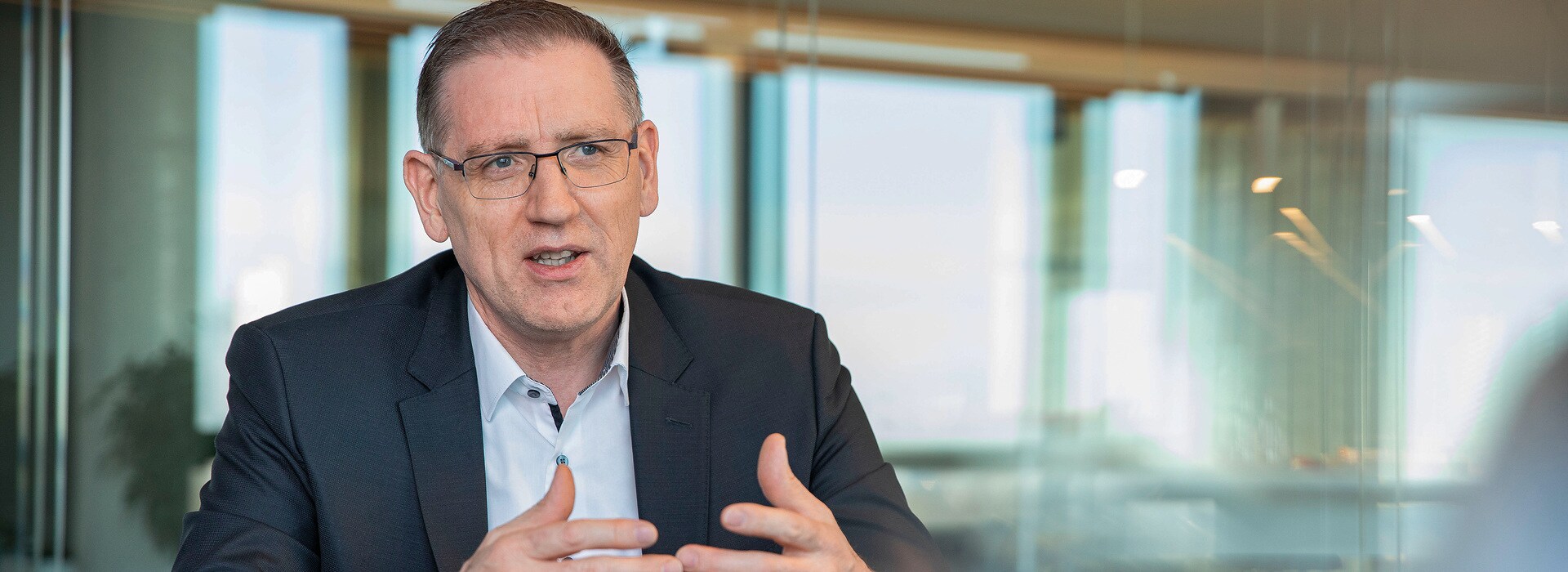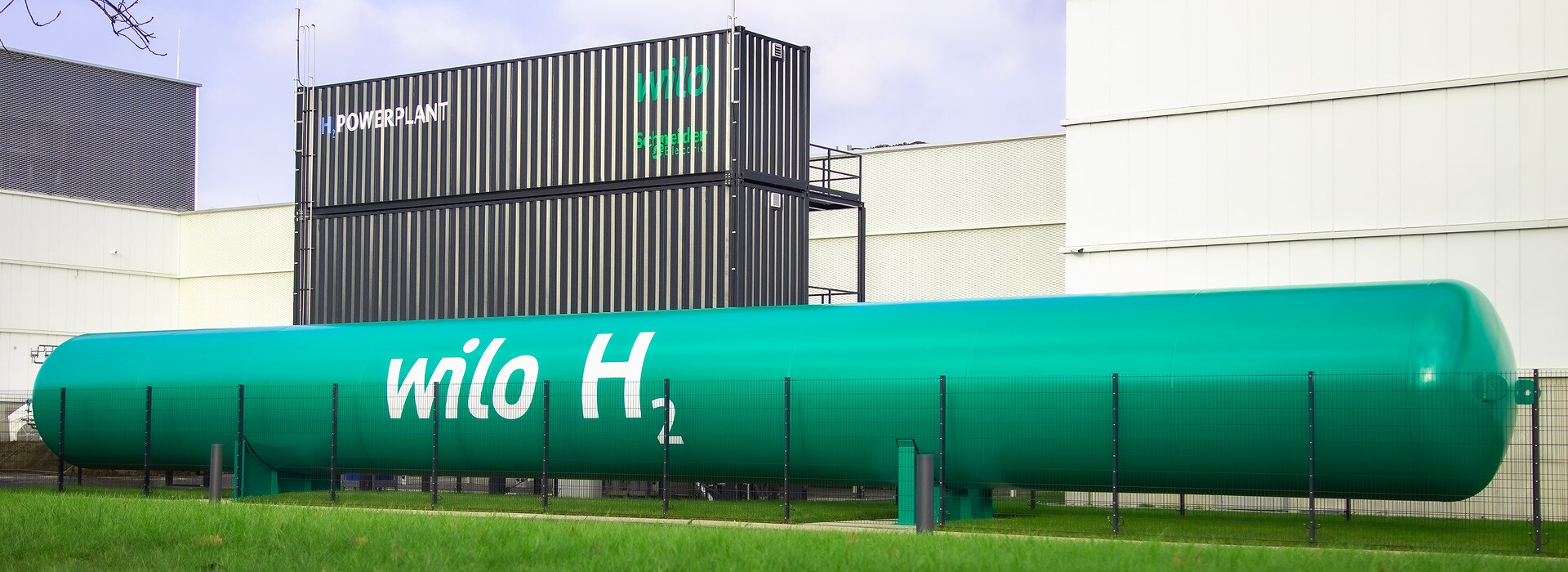Sustainability Report 2023: Interview with Georg Weber
“A major task, but we are on the right track and making good progress”
Georg Weber, member of the Executive Board and CTO of the Wilo Group, sits down for an interview in which he explains the technology company’s central sustainability goals.
Mr Weber, Wilo has a new sustainability strategy. Why?
We realised that it was time to make sustainability a much higher priority in our strategic direction and especially in our day-to-day activities. That is why we have tightened up our strategy and focused it even more sharply on the areas where Wilo makes a sustainable difference – so where we have an impact. I am very excited to be rolling up my sleeves again and to get cracking with all 9,000 or so of my colleagues.

Where does Wilo make a concrete impact then? Can you give us an example, please?
We concentrate on three major impact areas: Creating,Caring, Connecting. Let’s look at a very obvious example: our water solutions, which we have assigned to the Creating impact area. The strategic goal is to increase our market presence in the area of sustainable water solutions and thus to provide better access to clean water for 200 million people by 2030.
An ambitious goal.
It is ambitious, yes, but then so is Wilo. We have the products, systems and solutions to achieve this goal – covering everything from water supply through sewage disposal to water treatment. We have updated or completely revamped a third of the products just in this portfolio over the last five years. We can provide our customers all around the world with tailor-made solutions, whether they are in sub-Saharan Africa, in Southeast Asia or in Ireland. And always with the customary high energy efficiency.

But customers don’t want products that are sustainable only in operation any more; they’ve long wanted products that are sustainable during the whole life cycle.
That’s right. Which is why we have set ourselves the goal of providing life cycle analyses for 80 percent of our portfolio by 2030. These calculations offer two benefits: they create transparency for our customers about a product’s carbon footprint. And they help us identify where we can be even better.
We all know what comes at the end of a product life cycle: recycling. What is Wilo’s approach here?
We are proud that the potential recycling rate of our products is almost 100 percent thanks to our recycling- friendly product design. What’s more, we initiated a process together with our customers a few years ago to take back decommissioned pumps from the market and to enable us to recycle them. And we are going to reach another milestone very soon: After several years of research, we are about to start producing magnets made of reclaimed magnetic powder. Magnets, which we urgently need for our high-efficiency pumps, actually contain rare earths. The switch to recycled raw materials therefore protects the environment and reduces dependencies.

Georg Weber, member of the Executive Board and Chief Technology Officer (CTO) of the Wilo Group, is responsible for sustainability management. His other areas of responsibility include research and development, procurement and supply chain management, operations, quality and location management.
A key factor in the sustainability management of industrial enterprises is their in-house energy consumption. What progress has Wilo made here?
Production at all of Wilo’s European and Chinese sites is currently climate neutral, and this will be the case for all of our sites worldwide by 2025. This means we will achieve an ambitious goal that we set for ourselves a few years ago. This success is thanks to significant investments that we have made in the past few years – for example, in photovoltaic systems. Our current capacity is 20 megawatt peak. In Hof, we gave the green light for the start of an innovative concept that is primarily based on local heating. And in Dortmund we famously invested in the innovative H2POWERPLANT hydrogen facility, which is now an important component of the Wilopark energy concept.
What makes the H2POWERPLANT at the Dortmund site stand out?
The pilot plant in Dortmund produces green hydrogen from energy generated by the photovoltaic system on the roof of the Smart Factory. A fuel cell can then be used to convert the hydrogen back into electrical energy when it’s needed. The waste heat is either used in the interconnected system for heating, stored or converted into cooling on-site.
Let’s look at Wilo’s supplier network. How do you manage to take sustainability into account early in the procurement process?
By conducting training programmes that encourage our suppliers to do this – and by emphasising how important sustainability is to us right from the procurement process. Our sustainability strategy also highlights this. The aim here is for 100 percent of our key suppliers to be able to display EcoVadis certification by 2030. For classification purposes: We already expect the proportion to reach 20 percent in 2024. It’s a major task, but we are on the right track and making good progress.
Another major task is to reduce scope 3 emissions, meaning the emissions that Wilo products, systems and solutions cause when they are in operation.
Reducing the key scope 3 figure is indeed a major task. Wilo has grown continuously for several years. That means we have been selling ever greater numbers of pumps and pump systems. The consequences are firstly that more and more old, uncontrolled pumps are being replaced by high-efficiency Wilo pumps. And secondly that more efficient pumps are being used in new projects. Emissions are avoided in both cases.
You have undertaken to reduce scope 3 emissions by 25 percent by 2030. How are you going about that?
We have launched some major initiatives. A lot of our colleagues have contributed some wonderful ideas.The fact is, our products need electricity. But it should be green electricity whenever possible. We thus rely on the cooperation of our customers – on the one hand to reduce actual emissions and on the other, to build up more precise knowledge about how our products operate and thus to be able to calculate the scope 3 emissions much more accurately and then to reduce them. In all the calculations of these performance indicators, we can’t lose sight of the fact, however, that every new, high-efficiency Wilo pump that replaces anolder pump with higher energy consumption is effectively saving energy.
If we look at the social component of sustainability, we look at the employees.
I’m very happy to. At Wilo, it is people that take centre stage – that is our promise. Everything we do is ultimately aimed at making life easier for people. That is why the satisfaction and well-being of our employees is so important to us, as can be measured, for example, by the Employee Engagement Score, where we score higher than the industry average. We have just broken ground on the construction of the Health Cube – this project represents a significant investment in the health of our employees. And we have now hit the benchmark level globally in the number of accidents at the workplace, to mention just a few examples here.
Wilo’s sustainability management is exemplary when we look at the environment and people. That is clearly demonstrated by awards such as the EcoVadis platinum rating. But what are you doing to share your knowledge with other people?
This is where our impact area Connecting comes into play. We are involved in a large number of strong partnerships. But this isn’t just about sharing our knowledge – it’s also about learning from other people! It is only in this way that the major challenges of our times – meaning climate change – can be tackled and that synergies can be leveraged. This is why we are involved in networks around the world and, in fact, to a far greater extent than is customary.











